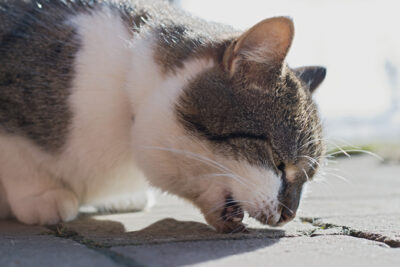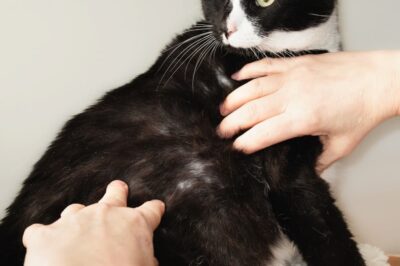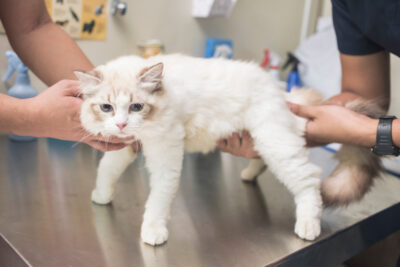Hot Spots on Cats

If you’ve ever noticed a red, moist, irritated patch of skin on your favorite feline, you’re not alone. These painful skin lesions could be what’s known as hot spots on cats (or acute moist dermatitis). And they are all too common in our furry friends.
Without proper treatment, a feline hot spot can worsen quickly and lead to frequent vet visits. So here’s a simple guide to help pet parents recognize the signs of cat hot spots, the causes, and how to treat and prevent them.
Whether you’re dealing with a current cat rash or just want to know what to look out for, we’ve got you covered. Let’s dive into this common kitty skin condition.
Hot Spots on Cats: What Are They?
A hot spot is a red, inflamed area on your cat’s skin. It occurs when a cat’s excessive licking, chewing, scratching, or biting leads to skin damage or irritation. This repeated self-trauma disrupts the skin’s natural barrier, allowing normal skin bacteria to overgrow and cause infection.
The term “hot spot” comes from the affected skin’s look and feel. The resulting lesion often becomes red, moist, inflamed, painful, and hot or warm to the touch.
While cat hot spots may look like other rashes or skin conditions, there are a few key differences. A hot spot is limited to the area where the excessive licking, scratching, or biting occurs. Rashes are typically more widespread with various underlying causes beyond self-trauma. They may look more like red dots on cat’s skin, rather than red, moist patches.
Are hot spots contagious or painful?
Yes, hot spots are painful for your cat; but they are not contagious to other pets or people. However, the underlying cause (like fleas or ringworm) might be.
What Do Cat Hot Spots Look Like?

It’s important to know how to recognize cat hot spots, which can appear suddenly (even within a few hours). Keep an eye out for:
- Bright red, moist areas of skin
- Hair loss around the irritated spot
- Oozing, crusting, or scabbing
- Matted fur over the lesion
- Swelling or sensitivity when touched
Hot spots often appear on a kitty’s neck, face, chin, belly, or base of the tail. Typically, they begin as small lesions, but can grow quickly if the overgrooming continues or treatment is delayed.
Sometimes, you may be able to detect clues that your cat has a hot spot, even if you don’t see one. Signs of a hot spot on a cat may include:
- Constant licking, biting, or scratching
- Odor from the infected area
- Changes in behavior (like hiding or being irritable)
Common Cat Hot Spot Causes
Many different things can lead to hot spots in cats, especially anything that causes itching or skin discomfort. This can lead to persistent biting, grooming, or scratching, which may result in hot spots.
So, what causes hot spots on cats? Common factors that can trigger hot spots include:
- Fleas and parasites: Flea bites, especially in cats with flea allergies, are a top cause. In cats with flea allergy dermatitis, flea saliva causes intense itching and scratching. Other parasites, like ear and skin mites, lice, and ant or mosquito bites, can also cause irritation.
- Allergies: Environmental allergens (e.g., pollen or dust mites), food allergies/sensitivities, and contact allergies can make your cat’s skin itchy and inflamed.
- Skin infections: Bacterial infections or fungal issues like ringworm can trigger irritation and itching, leading to a hot spot.
- Pain and injury: Cats with localized pain — due to osteoarthritis, trauma, or even post-surgery discomfort — may overgroom that area.
- Stress or anxiety: Some cats groom excessively when stressed, which can cause skin damage.
- Ear infections and matted fur: These can trap moisture and irritants, making the skin more prone to developing hot spots.
Hot spots can appear year-round, but they’re more common in warm, humid weather. Long-haired cats and those with dense coats are especially at risk. This is because moisture can get trapped under their fur and irritate the skin.
How Vets Diagnose Hot Spots on Cats
Diagnosing a hot spot usually requires an in-person visit to your veterinarian’s office. Your vet will begin with a physical exam, assessing the hot spot’s appearance, location, and severity. They may need to shave or clip the fur around the area to fully see the extent of the irritation.
To understand what caused the hot spot, your vet may perform additional tests, such as:
- Skin cytology – using tape to collect skin cells, then checking for bacteria or yeast under a microscope
- Skin scraping – to check for mites or other parasites
- Fungal culture – to confirm ringworm infections
- Allergy testing or blood work, especially in recurrent cases with frequent flare-ups.
Cat Hot Spot Treatment Options

The main goals of hot spot treatment for cats are to reduce pain, stop the itching, and treat the underlying cause. Treatment for hot spots on cats may depend on the location of the hot spot, such as the neck, tail, face, or paws, which may be more sensitive.
How vets typically treat hot spots on cats
Your veterinarian will take several steps to help your cat feel better during the veterinary visit:
- Clipping the fur: This helps expose the wound to air and makes it easier to clean and treat. For lesions in sensitive areas, vets may use sedation first to help relax your cat.
- Cleaning the area: Removes dirt, debris, and bacteria.
- Topical treatments: May include hot spot spray for cats, ointments, or wipes designed to reduce bacteria, inflammation, and/or pain. Though it depends on the lesion, vets tend to use topical antimicrobial therapies (often containing the antiseptic chlorhexidine) over topical antibiotics. This helps minimize the risk of antibiotic resistance, which is a growing concern in both veterinary and human medicine.
- Oral medications: For more severe cases, your vet may prescribe hot spot medication like oral antibiotics or anti-inflammatory drugs.
- Addressing the underlying cause: If your vet can pinpoint what caused the excessive grooming (e.g., flea infestation or arthritic joint pain), they’ll need to treat that. Otherwise, the hot spots will simply recur as the underlying issues worsen.
- Protecting the wound: To prevent further self-trauma, your cat might need an Elizabethan collar or other barrier that restricts licking or scratching during healing.
With proper feline hot spot treatment, most mild cases heal within 3 to 5 days. More serious or infected hot spots may take 2 to 3 weeks to fully heal.
Cost of treatment:
Treating a hot spot can cost anywhere from $100 to $300 or more, depending on the severity and any tests or medications required.
Home Remedies for Hot Spots on Cats
If you’re tempted to treat your cat’s hot spots on your own…don’t. Feline hot spots can be complex and may worsen quickly without proper treatment. So always consult your veterinarian first to get the correct diagnosis and treatment plan.
That said, with your vet’s okay, there are a few cat hot spots home remedies that may help soothe mild skin irritation. Ask your vet if your cat could benefit from the following:
- Cool compresses: Can reduce swelling and discomfort.
- Diluted chlorhexidine spray: A vet-approved antiseptic that may help prevent infection.
- Aloe vera gel (pure and pet-safe): Can soothe itching.
- Keeping the area clean and dry: Moisture makes hot spots worse.
Note: Never apply human creams, essential oils, or over-the-counter medications without your vet’s guidance, as these may be toxic to cats.
How to Prevent Hot Spots on Cats
Preventing hot spots on cats often means preventing the things that cause them in the first place.
Tips to help prevent hot spots in cats:
- Use regular flea and parasite prevention.
- Keep your cat’s coat clean and brushed, especially if long-haired.
- Check for ear infections, matted fur, or hidden wounds.
- Address stress or anxiety through enrichment and consistent routines.
- Identify and treat allergies or chronic skin issues with your vet’s help.
- Clip your cat’s claws to reduce skin damage from scratching (only for indoor cats).
Some vets may recommend dietary supplements like omega-3 fatty acids to promote healthy skin and reduce inflammation.
If you notice a hot spot on your cat, don’t wait to get it checked. These painful skin sores can spread fast. And the sooner you get treatment, the faster your cat will feel better. With the right care, you can help your cat heal and prevent future hot spots from coming back.









